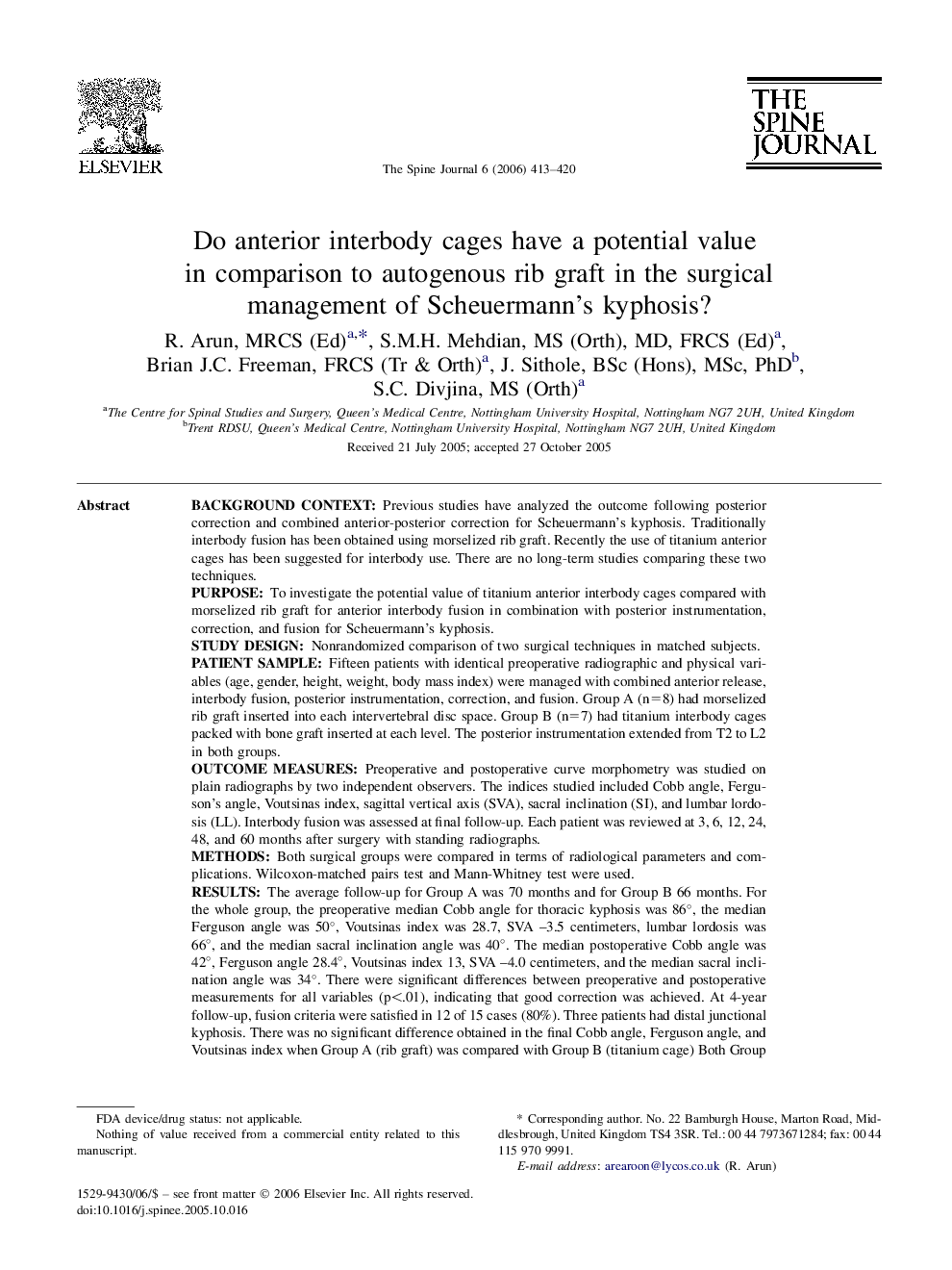| کد مقاله | کد نشریه | سال انتشار | مقاله انگلیسی | نسخه تمام متن |
|---|---|---|---|---|
| 4100312 | 1268684 | 2006 | 8 صفحه PDF | دانلود رایگان |

Background contextPrevious studies have analyzed the outcome following posterior correction and combined anterior-posterior correction for Scheuermann's kyphosis. Traditionally interbody fusion has been obtained using morselized rib graft. Recently the use of titanium anterior cages has been suggested for interbody use. There are no long-term studies comparing these two techniques.PurposeTo investigate the potential value of titanium anterior interbody cages compared with morselized rib graft for anterior interbody fusion in combination with posterior instrumentation, correction, and fusion for Scheuermann's kyphosis.Study designNonrandomized comparison of two surgical techniques in matched subjects.Patient sampleFifteen patients with identical preoperative radiographic and physical variables (age, gender, height, weight, body mass index) were managed with combined anterior release, interbody fusion, posterior instrumentation, correction, and fusion. Group A (n=8) had morselized rib graft inserted into each intervertebral disc space. Group B (n=7) had titanium interbody cages packed with bone graft inserted at each level. The posterior instrumentation extended from T2 to L2 in both groups.Outcome measuresPreoperative and postoperative curve morphometry was studied on plain radiographs by two independent observers. The indices studied included Cobb angle, Ferguson's angle, Voutsinas index, sagittal vertical axis (SVA), sacral inclination (SI), and lumbar lordosis (LL). Interbody fusion was assessed at final follow-up. Each patient was reviewed at 3, 6, 12, 24, 48, and 60 months after surgery with standing radiographs.MethodsBoth surgical groups were compared in terms of radiological parameters and complications. Wilcoxon-matched pairs test and Mann-Whitney test were used.ResultsThe average follow-up for Group A was 70 months and for Group B 66 months. For the whole group, the preoperative median Cobb angle for thoracic kyphosis was 86°, the median Ferguson angle was 50°, Voutsinas index was 28.7, SVA –3.5 centimeters, lumbar lordosis was 66°, and the median sacral inclination angle was 40°. The median postoperative Cobb angle was 42°, Ferguson angle 28.4°, Voutsinas index 13, SVA –4.0 centimeters, and the median sacral inclination angle was 34°. There were significant differences between preoperative and postoperative measurements for all variables (p<.01), indicating that good correction was achieved. At 4-year follow-up, fusion criteria were satisfied in 12 of 15 cases (80%). Three patients had distal junctional kyphosis. There was no significant difference obtained in the final Cobb angle, Ferguson angle, and Voutsinas index when Group A (rib graft) was compared with Group B (titanium cage) Both Group A and B patients retained the postoperative correction achieved with respect to all the radiographic parameters studied.ConclusionWe were unable to demonstrate any significant advantage for the use of anterior titanium interbody cages over the use of morselized rib graft in the surgical management of Scheuermann's kyphosis. Given the not inconsiderable cost and the need for posterior chevron osteotomies when interbody cages are used, we have now reverted to our previous practice of using morselized rib graft at each intervertebral level.
Journal: The Spine Journal - Volume 6, Issue 4, July–August 2006, Pages 413–420